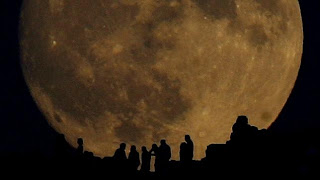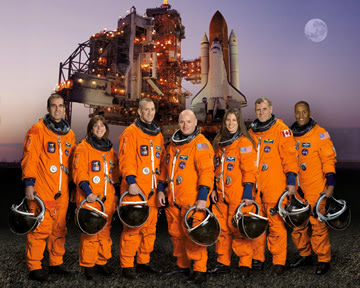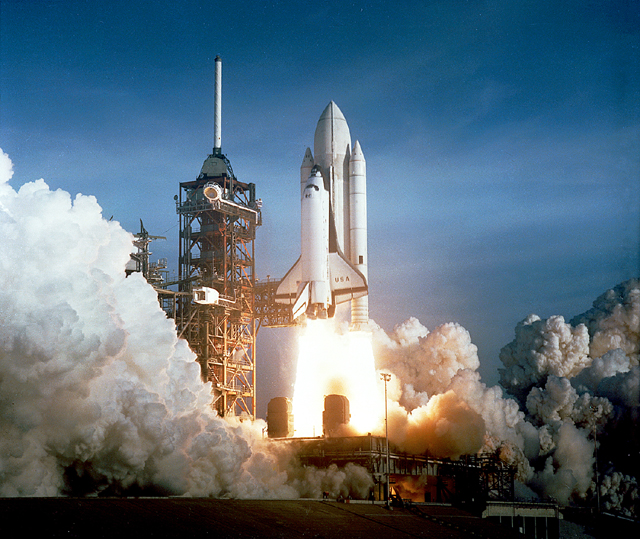NASA is reviewing data from SpaceX's historic December demo mission of the Dragon capsule before approving the company's request to send its next test flight all the way to the International Space Station.
SpaceX displayed the Dragon capsule in Washington last week. Credit: Stephen Clark/Spaceflight Now
Agency and company officials say the Dec. 8 orbital test of the
Dragon spacecraft was successful. NASA has already paid a $5 million award for the milestone under the Commercial Orbital Transportation Services, or COTS, program, an agreement between the agency and firms developing resupply vehicles for the
space station.
But NASA officials aren't quite ready to honor SpaceX's public request to combine its next two test flights into a single action-packed mission in July to prove the Dragon's ability to service the space station.
"There were a number of observations tracked during the flight that need to be resolved before the next one," said Alan Lindenmoyer, manager of NASA's commercial crew and cargo program at the Johnson Space Center in Houston. "Nothing major, but certainly things that need to be addressed before SpaceX attempts the next demonstration flight."
Lindenmoyer said NASA and SpaceX are studying data from the mission in a process leading up to a flight readiness review before the next launch.
"There was nothing significant I think would hold up the next flight," Lindenmoyer said. "It's just a matter of routine engineering analysis that has to be done to correct those observations."
NASA has also asked SpaceX to submit a proposal to the agency verifying the spacecraft's ability to accomplish objectives of the second and third demonstration flights originally laid out several years ago.
"We've asked a number of technical questions," Lindenmoyer said. "Do they have the propellant performance, the margin, the capabilities, the timeline and the training? There are a lot of things that have to be done because this will be an extended mission. You have to accomplish all the objectives of the second flight. It involves breakout maneuvers, multiple approaches to the station, things that are normally done on any first flight of a new vehicle to the station."
The COTS plan calls for a second Dragon test flight to rendezvous with the space station before backing away. A third demo mission was supposed to proceed within about 30 feet of the complex, close enough for the station's robot arm to grapple the craft and attach it to one of the lab's berthing ports.
SpaceX wants to consolidate the two flights and fly the next mission to a berthing on the complex. The company says an all-in-one flight would accelerate SpaceX's 12 operational space station resupply missions under a $1.6 billion contract with NASA.
Combining the missions would require the Dragon to achieve the goals of both flights, including fuel-burning abort and retreat tests and extensive thruster firings. If the spacecraft is healthy and still has enough propellant, mission controllers could send the capsule closer to the space station for berthing.
The space agency expects final documentation from SpaceX in the "coming weeks," then NASA will be ready to decide on the flight test program.
"Is it technically possible? Are the crews properly trained? It spans different increment crews on-orbit, so that's a factor," Lindenmoyer said. "We had been planning for a longer period, and now we have to see if all of that planning can be done. Those are the things we're looking at right now."
Elon Musk, SpaceX's founder and CEO, told Spaceflight Now last week there is not "any major question that Dragon can combine both missions."
NASA and SpaceX officials would not disclose what issues were observed during the Dragon test flight, which orbited Earth twice after launching on a Falcon 9 rocket from Cape Canaveral, Fla. The 9.5-foot-tall capsule splashed down under parachutes in the Pacific Ocean.
The growing space contractor is in the final stages of testing its Falcon 9 rocket and Dragon capsule for unmanned cargo delivery missions to the space station.
SpaceX expects to introduce solar panels, cargo racks, rendezvous sensors and a berthing mechanism on the next Dragon mission. None of
SpaceX displayed the Dragon capsule in Washington last week. Credit: Stephen Clark/Spaceflight Now
Agency and company officials say the Dec. 8 orbital test of the Dragon spacecraft was successful. NASA has already paid a $5 million award for the milestone under the Commercial Orbital Transportation Services, or COTS, program, an agreement between the agency and firms developing resupply vehicles for the space station.
But NASA officials aren't quite ready to honor SpaceX's public request to combine its next two test flights into a single action-packed mission in July to prove the Dragon's ability to service the space station.
"There were a number of observations tracked during the flight that need to be resolved before the next one," said Alan Lindenmoyer, manager of NASA's commercial crew and cargo program at the Johnson Space Center in Houston. "Nothing major, but certainly things that need to be addressed before SpaceX attempts the next demonstration flight."
Lindenmoyer said NASA and SpaceX are studying data from the mission in a process leading up to a flight readiness review before the next launch.
"There was nothing significant I think would hold up the next flight," Lindenmoyer said. "It's just a matter of routine engineering analysis that has to be done to correct those observations."
NASA has also asked SpaceX to submit a proposal to the agency verifying the spacecraft's ability to accomplish objectives of the second and third demonstration flights originally laid out several years ago.
"We've asked a number of technical questions," Lindenmoyer said. "Do they have the propellant performance, the margin, the capabilities, the timeline and the training? There are a lot of things that have to be done because this will be an extended mission. You have to accomplish all the objectives of the second flight. It involves breakout maneuvers, multiple approaches to the station, things that are normally done on any first flight of a new vehicle to the station."
The COTS plan calls for a second Dragon test flight to rendezvous with the space station before backing away. A third demo mission was supposed to proceed within about 30 feet of the complex, close enough for the station's robot arm to grapple the craft and attach it to one of the lab's berthing ports.
SpaceX wants to consolidate the two flights and fly the next mission to a berthing on the complex. The company says an all-in-one flight would accelerate SpaceX's 12 operational space station resupply missions under a $1.6 billion contract with NASA.
Combining the missions would require the Dragon to achieve the goals of both flights, including fuel-burning abort and retreat tests and extensive thruster firings. If the spacecraft is healthy and still has enough propellant, mission controllers could send the capsule closer to the space station for berthing.
The space agency expects final documentation from SpaceX in the "coming weeks," then NASA will be ready to decide on the flight test program.
"Is it technically possible? Are the crews properly trained? It spans different increment crews on-orbit, so that's a factor," Lindenmoyer said. "We had been planning for a longer period, and now we have to see if all of that planning can be done. Those are the things we're looking at right now."
Elon Musk, SpaceX's founder and CEO, told Spaceflight Now last week there is not "any major question that Dragon can combine both missions."
NASA and SpaceX officials would not disclose what issues were observed during the Dragon test flight, which orbited Earth twice after launching on a Falcon 9 rocket from Cape Canaveral, Fla. The 9.5-foot-tall capsule splashed down under parachutes in the Pacific Ocean.
The growing space contractor is in the final stages of testing its Falcon 9 rocket and Dragon capsule for unmanned cargo delivery missions to the space station.
SpaceX expects to introduce solar panels, cargo racks, rendezvous sensors and a berthing mechanism on the next Dragon mission. None of those systems flew on the December flight.
"This hardware is almost through qualification and should be complete no later than June," said Kirstin Brost, a SpaceX spokesperson. "Then Dragon will go through a series of virtual mission simulations with flight hardware in the loop. SpaceX will be ready to launch this summer, pending final approval from NASA's space station safety review board."
SpaceX has invested about $600 million in the Falcon 9 rocket and Dragon spacecraft, according to Tim Hughes, the company's vice president and general counsel.
Musk says it will cost about $1 billion to modify and test the Dragon capsule for astronaut crews.
Human missions could begin in about three years, assuming SpaceX receives a NASA contract soon, according to SpaceX officials. those systems flew on the December flight.
"This hardware is almost through qualification and should be complete no later than June," said Kirstin Brost, a SpaceX spokesperson. "Then Dragon will go through a series of virtual mission simulations with flight hardware in the loop. SpaceX will be ready to launch this summer, pending final approval from NASA's space station safety review board."
SpaceX has invested about $600 million in the Falcon 9 rocket and Dragon spacecraft, according to Tim Hughes, the company's vice president and general counsel.
Musk says it will cost about $1 billion to modify and test the Dragon capsule for
astronaut crews.
Human missions could begin in about three years, assuming SpaceX receives a NASA contract soon, according to SpaceX officials.





























